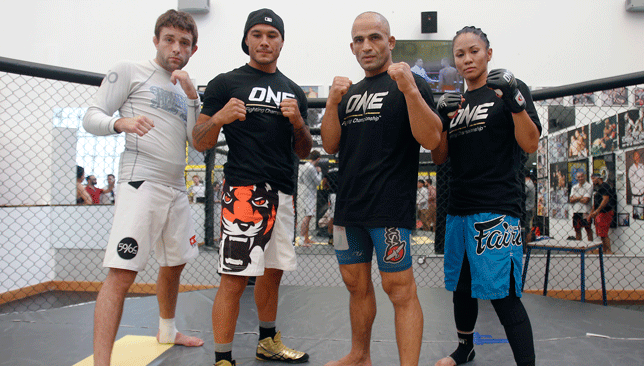
This weekend, Dubai will get to host its first ONE Fighting Championship event at the World Trade Centre where the UAE crowd will get to witness an incredible fight card that includes three world championship bouts.
Mixed martial artists are the most well-rounded athletes on the planet when it comes to overall fitness. No other sport combines such a wide variety of disciplines and techniques the way MMA does, which is why the fighters undergo some of the most rigorous training to get lean bodies that hold immense strength, endurance and power.
Talk to any mixed martial artist in the world and they’ll tell you that MMA “is a way of life”.
The sport is not confined to an octagon, cage, ring, gym, or arena.
Once you’re an MMA fighter, the sport encompasses everything you do.
“People sometimes just see MMA on the flat screen, they see this fighting and they think ‘oh they’re just beating each other up’. But behind that it goes so far, it's a big planet,” Iranian fighter Kamal Shalorus told Sport360.
“There’s so much discipline, so much respect, so much sacrifice. We become like monks and treat our bodies like a temple. We train all day and we eat healthy.
“Sometimes my friends ask me to go to a restaurant with them and I say ‘honestly I just have to stay home and cook my own meal’. As MMA fighters you have to love nature, you have to love people, you have to be so calm. That’s why I love being an MMA fighter, you become a real warrior.”
Shalorus, 36, is a former national wrestler who transitioned into MMA and will be taking on grappling legend Shinya Aoki in Dubai on Friday.
The Iranian, nicknamed “The Prince of Persia”, says he focuses equally on the different martial arts and doesn’t rely heavily on his wrestling experience.
“I focus on everything, I like to be well-rounded. You have to prepare for everything. You can’t go to war and think ‘he’s not going to shoot me, he’s just going to stab me’,” said Shalorus. “We train in so many different ways. We do running, swimming, climbing, yoga, meditation and so on. Every single muscle has to work together with the rest of your body.”
Roger Huerta, an American fighter of Salvadorian and Mexican descent, follows a similar approach to Shalorus as he refuses to favour one art to another.
“MMA is a lifestyle, you have to live and breathe it,” said Huerta. “I’ve been training six to eight-hour days (during the camp leading up to the fight). In the morning sometimes cardio sessions, jiu-jitsu sessions, Muay Thai sessions, wrestling sessions, you name it.
Ana Julaton, a Filipino former boxing world champion, moved from boxing to MMA and has already won her first ONE FC fight.
All fighters have to deal with the stress of maintaining a certain weight as they head into a pre-fight weigh-in and adopt different strategies to shed the necessary weight in time. Julaton has been dealing with the opposite as she is forced to add a few pounds.
“This is only my second fight, there’s a lot of things I’m still playing around with. I usually fight at 122 pounds for boxing so to fight at 125 for MMA, even though it doesn’t sound that much, just three pounds – it’s a lot in a fight game,” explains the 33-year-old. “Imagine a can of soda being thrown at you, that’s how much three pounds can be in combat sports. In boxing I tend to be fairly lean and for me to try and gain weight I have to eat a lot more than normal, but I think it’s been going well.”
Shalorus admits the period prior to a weigh-in is a difficult one and says: “The hardest part is losing weight. Most of the time we starve.
“Leading up to the weigh-in, we drink a lot of water, eat so clean, no carbs and then lose the last few pounds. Then after the weigh-in you go crazy and eat everything.”

Huerta follows a different approach. The American tries to avoid extreme measures and prefers to exert more effort to burn off the calories.
“It’s never easy. It gets easier but it’s never going to be easy. Especially when you’re burning so many calories, your body needs calories,” says Huerta.
Leading up to Dubai, Julaton went through an intense eight-week training camp and had to adjust her training midway when her opponent changed from a Russian kickboxer called Irina Mazepa to Malaysian fighter Ann Osman. Julaton’s coach Angelo Reyes says she was putting in between eight and nine hours of training each day.
“I think what makes it interesting is when you have someone like Ana, who has so many abilities in her boxing, in her taekwondo, in her karate, and for this particular training camp she wanted to work on her wrestling and on her jiu-jitsu – that’s five different arts. So trying to squeeze that all in one day on top of strength and conditioning, makes for a pretty crazy routine,” says Reyes. “It’s very different (training in those various arts). It’s almost like saying baseball, basketball, football.”
Reyes explained how Julaton’s body had changed from her days as a boxer, where she used to train with Freddie Roach and Filipino superstar Manny Pacquiao.
“The particular style that Freddie Roach taught her for six, seven years was more a speed game, kind of like Manny’s, so your legs have to be really quick, explosive, your hands have to be able to throw 1000 punches,” he says.
“Compared to MMA, for this particular camp, she really worked a lot on wrestling and in wrestling you don’t punch and in jiu-jitsu you’re always on your back and the muscles kind of change, from her thighs to her hips to her back. It became like a well-rounded muscle group, kind of like George St-Pierre, that’s a good example of someone who does everything.”